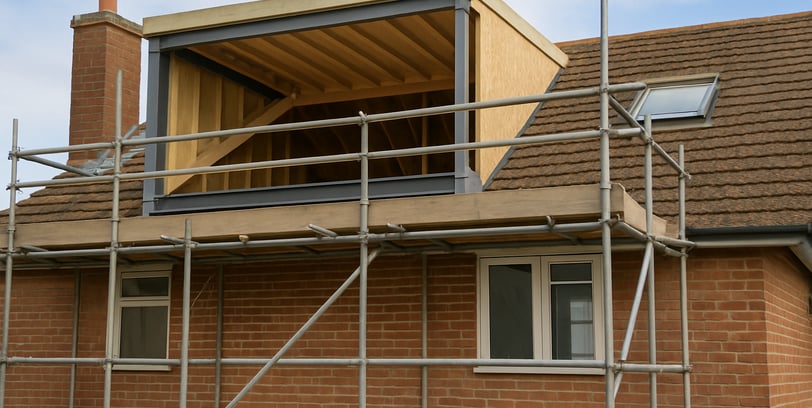Loft Conversion Complications UK | Common Issues & Smart Solutions
5/21/20253 min read


Loft Conversions in the UK: Common Complications and Smart Solutions
Loft conversions have become one of the most popular ways to expand living space in UK homes, especially in urban areas where land is limited. From creating a master suite to adding a home office, the benefits are clear. But what many homeowners don’t anticipate are the challenges and complications that can arise during the process.
If you’re planning a loft conversion in 2025, it’s crucial to understand the hurdles you might face—structurally, legally, or logistically—and how to plan ahead to avoid costly mistakes.
Common Complications in Loft Conversions
Insufficient Head Height
The minimum legal height from floor to ceiling in a loft conversion is 2.2 meters. If your existing loft doesn’t meet this:
You may need to lower the ceilings of the floor below.
Or raise the roof ridge, which often requires planning permission.
Solution:
Have a structural survey done early. A dormer or hip-to-gable conversion may solve the issue without lowering the floor.
Planning Permission Confusion
While most loft conversions fall under Permitted Development, this isn’t always the case.
Complications arise if:
Your property is in a conservation area
You’re planning a front-facing dormer
You live in a flat, maisonette, or listed building
You exceed the volume limits (40m³ for terraces, 50m³ for detached/semi)
Solution:
Apply for a Lawful Development Certificate (LDC) to confirm your build is permitted. If not, consult a planning consultant before submitting full plans.
Structural Issues
Lofts were not originally designed to carry extra weight. When converting, issues may include:
Overloaded joists
Weak or missing purlins
Load-bearing walls not aligning properly
Need for steel beams to support dormers or new floor structures
Solution:
Hire a qualified structural engineer to carry out full calculations. These are required for building regulations approval and safe construction.
Party Wall Agreements
If you live in a terraced or semi-detached property, you’ll need a Party Wall Agreement with your neighbor if the work involves:
Cutting into the party wall
Building new walls up to or astride the boundary
Excavating near foundations
Solution:
Serve a Party Wall Notice at least two months in advance. If your neighbour disputes it, you’ll need to appoint a surveyor (or two). Factor in time and cost.
Restricted Access
A new staircase must be fitted to access your loft legally. But complications arise when:
There’s not enough space on the landing
The staircase interrupts other rooms
Headroom is too low at the top of the stairs
Solution:
Design a winder staircase, or consider positioning it over an existing staircase to reduce impact. Consult your architect early.
Building Regulations Compliance
Even if planning permission isn’t needed, you must still meet building regulations, including:
Fire safety (Part B): Fire doors, alarms, safe escape routes
Sound insulation (Part E)
Structural stability (Part A)
Ventilation (Part F)
Stairs (Part K)
Solution:
Appoint a building control inspector from day one. Some hire private inspectors for faster service than local authorities.
Roof Shape Limitations
Your existing roof shape greatly impacts what type of conversion is possible:
Trussed roofs (common post-1960s) are harder to convert than traditional cut timber roofs
Complex or intersecting roofs may limit usable space
Low-pitched roofs reduce headroom
Solution:
An L-shaped dormer or full-width rear dormer often works best. You may need to reconfigure or strengthen the roof structure.
Weather-Related Delays
UK weather is notoriously unpredictable. Delays can result from:
Heavy rain during roof removal
Wind damaging temporary structures
Moisture exposure affecting new materials
Solution:
Schedule work between April and September. Use temporary roof coverings to keep interiors dry during open-roof phases.
Cost Overruns and Budget Blowouts
Unexpected structural fixes, council fees, or design changes can quickly spiral costs.
Typical extras:
Reinforcing joists or adding steel beams
Reconfiguring stairs or bathrooms
Party wall surveyor fees
Upgraded fire safety system
Solution:
Set aside a 10–15% contingency in your budget. Get fixed-price quotes from reputable contractors and keep detailed drawings.
Neighbour Disputes
Noise, scaffolding, blocked driveways, or loss of light can trigger disputes.
Solution:
Be proactive. Talk to your neighbors before work starts. Share your plans and schedule. Respect party wall procedures and permitted hours.
How to Avoid or Overcome Loft Conversion Problems
Hire experienced professionals: Choose an architect and contractor who specialize in lofts. Ask for past projects and reviews.
Plan ahead: Secure your planning approvals and building control sign-offs before work starts.
Don’t cut corners: Cheap work leads to costly repairs. Always use qualified tradespeople.
Invest in design: A well-designed loft conversion saves space, adds light, and increases home value.
Communicate: Keep in touch with your project manager, neighbours, and surveyors throughout the build.
Final Thoughts: Be Prepared for a Smoother Loft Build
A loft conversion is a smart investment—adding space and value to your UK home. But complications are common. With the right planning, the right team, and awareness of the risks, you can enjoy a stunning new loft with minimal disruption.
Avoid shortcuts, understand the rules, and prepare for the unexpected—and your conversion will be a success.